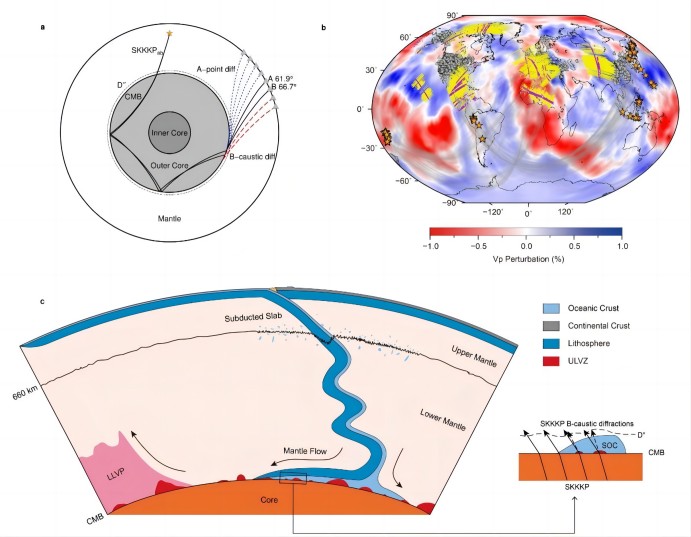Recently, the Innovation Academy for Precision Measurement Science and Technology (APM) has collaborated with research teams from the University of Science and Technology of China and international peers to develop a new method for detecting the ultra-low velocity zone at the core-mantle boundary using the SKKKP B focal phase extension seismic wave. This method has revealed the existence of small- to medium-scale ultra-low velocity zones within large-scale high-velocity anomaly regions at the global core-mantle boundary, providing key information for the study of the formation mechanism of ultra-low velocity zones.
The relevant research findings were published online on March 4th in the international academic journal Nature Geoscience.
As one of the most important boundaries within the earth, the core-mantle boundary layer connects the liquid outer core with the solid mantle and is one of the most complex regions in terms of physical structure and dynamical processes. It is of great significance for studies on the evolution of the earth's magnetic field, changes in the earth's rotation, and the earth's reference frame. Over the past few decades, seismic observations have shown the existence of multi-scale inhomogeneous structures above the core-mantle boundary, including large low-velocity provinces (LLVPs), medium-to-small-scale ultra-low velocity zones (ULVZs), and even smaller-scale scatterers. As the most extremely anomalous structure in terms of physical properties above the core-mantle boundary, the velocity of transverse waves in ultra-low velocity zones can decrease by up to 50%, and the velocity of longitudinal waves can decrease by up to 25%. The thickness of these zones varies from a few kilometers to tens of kilometers, and their lateral scale varies from tens of kilometers to thousands of kilometers. The structure and formation mechanism of ultra-low velocity zones are important aspects of fundamental research on mantle mineral composition, core-mantle material, energy, and angular momentum exchange.
The spatial distribution characteristics of ultra-low velocity zones can provide insights into their formation mechanisms. Existing seismic observations have shown that most ultra-low velocity zones are distributed within and on the edges of large low-velocity provinces. However, there is still uncertainty about whether ultra-low velocity zones exist widely in high-velocity anomaly regions at the core-mantle boundary. Focusing on this scientific question, the research team developed a new method for detecting ultra-low velocity zones at the core-mantle boundary using the SKKKP B focal phase extension seismic wave. This method effectively expands the sampling range of high-velocity anomaly regions at the core-mantle boundary.

(a)The ray paths of the newly discovered SKKKP B focal phase extension and its related seismic phases
(b)The new seismic phase significantly expands the sampling area at the core-mantle boundary
(c)Schematic diagram of the formation mechanism of ultra-low velocity zones
The research team not only discovered ultra-low velocity zones around the large low-velocity provinces beneath the Pacific Ocean and Africa, but also detected ultra-low velocity zones within previously underexplored high-velocity anomaly regions at the core-mantle boundary, including regions such as Central and South America, central and western Asia, Alaska, and Greenland (Figure 1b). By combining existing geodynamic simulation results, the study revealed the formation mechanism of ultra-low velocity zones within high-velocity anomaly regions at the core-mantle boundary: when a subducting plate enters the lower mantle, its overlying oceanic crust can gradually detach and sink to the core-mantle boundary. Because the melting point of oceanic crust material is lower than that of the surrounding mantle rocks, partial melting may occur to form ultra-low velocity zones (Figure 1c).
The research was funded by the National Natural Science Foundation of China and the Strategic Priority Research Program of the Chinese Academy of Sciences. SU Yulong, a doctoral student from the University of Science and Technology of China, was the first author of the paper, and Ni Sidao, an academician from the State Key Laboratory of Geodesy and Earth's Dynamics, APM, was the corresponding author. Collaborators included the team led by Academician SUN Heping, the Woods Hole Oceanographic Institution in the United States, and scholars from Arizona State University. Based on the "Institution-Laboratory Combination" policy, the laboratory has carried out long-term close cooperation with the Earth and Space Sciences School of the University of Science and Technology of China. They have made many important progress in the study of the internal structure and dynamics of the Earth. In recent years, a series of papers published by both sides cooperate in academic journals such as Science, Nature's sub-publications, and PNAS have deepened the understanding of scientific issues such as the internal operating mechanism of the Earth.
Link to the article:https://doi.org/10.1038/s41561-024-01394-5

